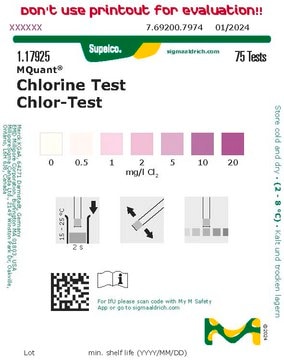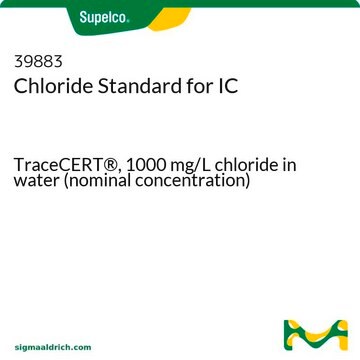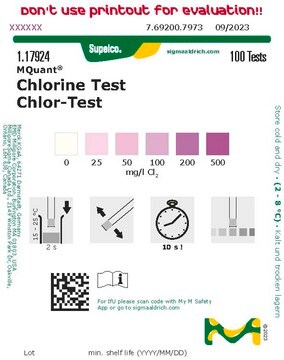All Photos(1)
About This Item
Empirical Formula (Hill Notation):
Cl2
CAS Number:
Molecular Weight:
70.91
Beilstein/REAXYS Number:
3902968
EC Number:
MDL number:
UNSPSC Code:
12142100
PubChem Substance ID:
NACRES:
NA.22
Recommended Products
vapor density
2.48 (vs air)
vapor pressure
4800 mmHg ( 20 °C)
grade
puriss.
assay
≥99.8%
resistivity
1E9 μΩ-cm, 20°C
evapn. residue
≤40 ppm
bp
−34 °C (lit.)
mp
−101 °C (lit.)
SMILES string
ClCl
InChI
1S/Cl2/c1-2
InChI key
KZBUYRJDOAKODT-UHFFFAOYSA-N
Looking for similar products? Visit Product Comparison Guide
Packaging
Cylinder with net ~6 kg
DIN 477 nr.8
Analysis Note
corresponds to DIN 19607 ′chlorine for water treatment′
Other Notes
Sales restrictions may apply
Recommended products
For 22754-6KG-F EU: Z742162/Z742164 DIN 1 Regulators OR 99112 DIN 1 Valve
For 22754-6KG-F US: Z146706 CGA 180 OR Z146943 CGA 110 valve with Z147095 CGA 110 to CGA 180 adapter and Z146986 washer for valve
For 22754-6KG-F US: Z146706 CGA 180 OR Z146943 CGA 110 valve with Z147095 CGA 110 to CGA 180 adapter and Z146986 washer for valve
signalword
Danger
Hazard Classifications
Acute Tox. 2 Inhalation - Aquatic Acute 1 - Eye Irrit. 2 - Ox. Gas 1 - Press. Gas Compr. Gas - Skin Irrit. 2 - STOT SE 3
target_organs
Respiratory system
Storage Class
2A - Gases
wgk_germany
WGK 2
flash_point_f
Not applicable
flash_point_c
Not applicable
ppe
Eyeshields, Faceshields, Gloves
Choose from one of the most recent versions:
Already Own This Product?
Find documentation for the products that you have recently purchased in the Document Library.
Per Bengtson et al.
Environmental microbiology, 11(6), 1330-1339 (2009-05-21)
Several studies have demonstrated that extensive formation of organically bound chlorine occurs both in soil and in decaying plant material. Previous studies suggest that enzymatic formation of reactive chlorine outside cells is a major source. However, the ecological role of
Marie Deborde et al.
Water research, 42(1-2), 13-51 (2007-10-05)
Numerous inorganic and organic micropollutants can undergo reactions with chlorine. However, for certain compounds, the expected chlorine reactivity is low and only small modifications in the parent compound's structure are expected under typical water treatment conditions. To better understand/predict chlorine
Melissa A Gessner et al.
American journal of physiology. Lung cellular and molecular physiology, 304(11), L765-L773 (2013-04-09)
Chlorine (Cl₂) is a highly irritating and reactive gas with potential occupational and environmental hazards. Acute exposure to Cl₂ induces severe epithelial damage, airway hyperreactivity, impaired alveolar fluid clearance, and pulmonary edema in the presence of heightened inflammation and significant
Suhail Ahmad et al.
Environmental research, 133, 20-26 (2014-06-07)
Invasive aspergillosis due to triazole-resistant Aspergillus fumigatus, a common airborne fungal pathogen, has emerged in some European and Asian countries, likely due to exposure to azole fungicides in the environment. This study determined the occurrence of triazole-resistant A. fumigatus in
N Salgueiro-González et al.
Journal of chromatography. A, 1281, 46-53 (2013-02-12)
This work describes the development and validation of a novel, simple, sensitive and environmental friendly analytical method for the determination of alkylphenols in different types of water samples. The methodology was based on a membrane assisted solvent extraction of only
Our team of scientists has experience in all areas of research including Life Science, Material Science, Chemical Synthesis, Chromatography, Analytical and many others.
Contact Technical Service

![3-[Bis(2-hydroxyethyl)amino]propyl-triethoxysilane solution technical, ~65% in ethanol](/deepweb/assets/sigmaaldrich/product/structures/346/789/6478c69e-26fa-46c4-919d-d90c61bc72ee/640/6478c69e-26fa-46c4-919d-d90c61bc72ee.png)










